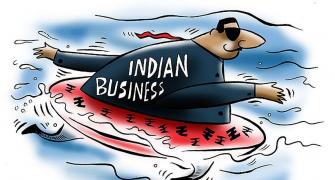With the onset of monsoon, albeit a little late, hopes of a revival of the bourses have been rising in the capital market.
The old economy stocks are back in the reckoning. Cement and infrastructure companies look strong bets, as do some textile and petrochemical majors.
A medium to long-term growth for select automobile/steel majors is also indicated on the charts, while divestment favourites cannot be ruled out.
For those with greater risk appetite, stocks like Zee Telefilms and the Maruti Udyog public offering should appear attractive over the short-term. And yes, keep the small note with technology stocks jotted, back in your pocket for the time being.
Following are the top 20 picks, which investors should look at, whether backed by a short or long term investment perspective:
The oldest and largest cement manufacturer in India, ACC continues to command a significant market share in each state to which it supplies. Its shipments in May rose 11.5 per cent from a year earlier to 13.79 lakh (1.379 million) tonnes. The off-take for cement and the fortunes for the construction sector will depend on the monsoons for the current year.
ACC appears to look strong over the short term. From a technical viewpoint, after taking support on the Rs 127 level for the third time in the past one year, ACC has bounced back smartly.
While there is strength in the rally, this ride is not expected to be trouble free, a decisive close above the Rs 155 level could free the stock from its shackles.
This could trigger off an intermediate uptrend with a tentative price target of Rs 173. ACC has been a slow mover when compared to stocks like Madras and India Cement making it an attractive and relatively low risk buy at current levels.
The flagship company of Rs 2,000 crore (Rs 20 billion) worth Lalbhai Group is one of India's most diversified business houses with a significant presence in textiles, ready-to-wear, agrochemicals and telecom industries in India.
The Arvind Mills scrip has witnessed strong trading interest since May 2003 and the main driver for the stock is the scrapping of the quota system from January 2005 (which restricts domestic companies from utilising their capacities to the full extent). With profitability strong in recent months due to its debt restructuring, Arvind Mills is expected to show strong growth in value-added products in the coming years.
From a technical viewpoint, the stock spent nine months dithering between Rs 18 on the downside and Rs 27 on the upside and then sprung back to life only in the tenth month. It overcame a significant supply line at Rs 23, which added fillip to the impending bull-run. In the midst of an intermediate uptrend, Arvind Mills seems poised to gain further ground and looks like a market outperformer with a medium term target of Rs 60.
The scrip was responsible for the renewed fancy in textile stocks and has been instrumental in bringing back the lost glory and seems set to continue as a flagship company of the sector making it an attractive buy especially on declines.
A leading player in motorbikes and three-wheelers, the company is lining up various new products in the coming months. It has consistently gained from higher volumes and sales of three wheelers, registering better operating margins for the year ending March 2003.
In bikes, the refurbished Caliber 115 is faring well and with two 125cc models expected by Q4 of the fiscal, Bajaj Auto is emerging as a clear performer in its group. Its growth in the three-wheeler segment continues, with exports of passenger carriers.
The scrip has taken support at the Rs 466 level 14 times in the last one and a half years or so making it a significant level. This, obviously, provided the launching pad for its ongoing rally and the resultant gains have been decent enough. Investors should not be judgemental regarding recent gains and the scrip seems to be preparing for further glory and working towards a big breakout on the upside.
The Rs 550 level could provide to be an obstacle while a close above this level could mean significant gains (in the range of 200 points or so) from a long tern point of view.
The stock appears to have played out its divestments card and thus may appear stretched at this stage. But there are several positives, which would make BPCL a stock to retain in one's portfolio at this stage.
Recent price agreements with Oil and Natural Gas Corporation indicate that domestic crude will rule lower than landed prices of imported crude. Earnings forecasts for the company are being raised marginally, for FY2004, on the back of cheaper domestic crude, compared to imports.
The company is expected to make moderate growth in retail and positive contribution from the LPG and kerosene businesses.
The run-up for the stock has been seen in January-February 2003, but the BPCL stock has priced in strong earnings as well as built in expectations of aggressive price gains, benefitting from HPCL's expected privatisation.
Concor
Container Corporation of India, a 63 per cent-owned subsidiary of the Indian Railways, is the sole domestic transporter of containerised goods by rail and holds a 31 per cent share of international cargo.
The PSU is poised for greater growth and revenues due to the steady rise of containerisation in the country.
Analysts expect between 15-20 per cent revenue compounded annual growth rate over the next two financial years. This will be due to the rise in containerisation and an increase in Concor's carrying capacity with 1,900 new wagons being acquired. Overall volumes are expected to grow by 15 per cent in FY03-05 as the external trade traffic rises.
The PSU operates 51 container terminals spread across the country and enjoys a significant competitive advantage and economies of scale due to scheduled services between major traffic centres, its nationwide terminal network and large base of rolling stock.
Investors should not be too concerned of government control as the management is operationally competent. The Concor scrip looks attractive and has risen sharply in recent sessions, so a consolidation is expected before further gains occur. Concor, however, is not a very liquid stock.
Leading engineering player Cummins India stands poised for strong growth due to the focus towards infrastructure and road projects. The company posted a 9 per cent increase in net profit in fiscal ended March 31, 2003, at Rs 94.30 crore (Rs 943 million) compared to Rs 86.30 crore (Rs 863 million).
The main triggers for growth include power generation and industrial applications businesses. The performance of its merged subsidiaries has been positive, with a 33 per cent growth in sales achieved. The company is also streamlining operations for its thrust in component and generation sets exports.
As with the infrastructure giant L&T, Cummins is likely to gain from the investments and implementation of infrastructure and road projects in the coming years.
The scrip has spent the last few years in virtual hibernation and has only recently shown signs of waking up. Grasim spent 26 months in a consolidation phase and has now made its intentions clear by entering a long-term uptrend. The Rs 348-level was a crucial barrier in terms of resistance and since this level has now been overcome, it would actually act as a base (read as support).
Grasim has had a run-up of more than Rs 100 in the past two months but the long-term picture seems to suggest that there is a lot of steam left while a medium to long-term price target of Rs 550 seems like a distinct possibility.
Maybe the worst is now over for the FMCG major. It is true that the monsoons could play a critical role in determining rural income and consumer spending, but early signals suggest that some of the fears over the delay in monsoon are overplayed.
The Hindustan Lever scrip peaked at an all time high of Rs. 324.90 during February 2000 and these levels have not been seen since. HLL made a series of progressively lower tops and bottoms to fall to an intra-week low of Rs 135.10 during the week ended April 25, 2003. This level was tested once again in the next couple of weeks but held firm, which in fact worked as a springboard for the scrip to launch an intermediate uptrend. HLL has overcome important resistance levels and seems set to continue this positive movement with a medium term target of Rs 183.
The second high profile refinery lined up for divestment, Hindustan Petroleum Corporation Ltd has seen a run-up earlier this year but still has some steam left. The divestment ministry is likely to begin the due diligence for HPCL by June-end and trading interest will remain strong when the process is completed by August-end.
The due-diligence exercise involves site visits and access to data room that will facilitate bidders to submit their technical bids.
Reliance Industries, the Essar group, global majors including Royal Dutch Shell, Kuwait Petroleum, Saudi Aramco, TotalFina and Chevron Texaco, had submitted expressions of interest to pick up government's stake in HPCL.
The government, which holds a 51 per cent stake in HPCL, will offer 34.01 per cent stake along with management control to a strategic investor. Post-divestment, the government stake in HPCL will come down to 12 per cent.
With the total reserves of crude in place, the domestic production of crude oil is likely to remain stable at 32 MMTPA for about the next five years. Due to the capacity additions the country has now reduced its dependency for petroleum products.
The country has become net exporter of petroleum products and exports will increase with new capacity additions taking place.
The government's thrust on infrastructure improvement is good news for the refining sector. There is growing competition on the marketing front and with the APM (administrative price mechanism) dismantling, refining companies are more self sufficient in terms of their product requirements.
The tobacco major announced slightly below expectation Q4FY03 results due to higher investments in newer FMCG businesses and a reversal in agri-trading profitability. However, the core tobacco profits are strong with earnings before interest, tax or EBIT up 24 per cent annually. The macro picture for the cigarette business is favourable with two successive years of flat excise and an expected delay in the implementation of the value added tax regime.
Cigarette volumes after rising 4 per cent in FY03 could rise as much as 6-7 per cent in the next 10 months. The hotels business could vastly improve their performance as newer hotels emerge out of their gestation period.
ITC remains a preferred stock in the FMCG sector and any slide in the stock should be seen as an opportunity to buy.
Technically, ITC has seen a rise and fall sequence in recent years but the range has become narrower due to an omnipresent supply line.
Currently ITC has overcome the 4-year-old tested supply line and it seems to be on the threshold of a long-term uptrend with a medium term price target of Rs 800.
Engineering and construction major Larsen & Toubro could see some amount of trading interest following recent developments. The company, according to the Confederation of Indian Industry, is set to become the first Indian company to bag a contract from the US-based Bechtel Corporation to take up large reconstruction work in post-war Iraq. This came after the visit of Indian companies to the conference hosted by Bechtel in Kuwait.
In its cement business, L&T said its May shipments in the domestic market rose 7 per cent from a year earlier to 1.07 million tonnes.
The automobile major has seen higher revenues in 2002-03 in its automobile and tractor businesses. While the agricultural growth and resultant tractor sales continue to dip over the past six months, the company has decided to focus sharply on automobiles to push the tractor business through overseas exports.
The M&M scrip peaked at an all time high of Rs 664.75 in the month of February 2000 and suffered a fall of immense proportions to hit a low of Rs. 50.90 in September 2001. A much delayed and unsustainable corrective rally followed and hit an intra-week low of Rs 78.75 during October 2002.
M&M reflected strength by moving sideways in a consolidation phase before showing positive and decisive price action in the last month itself, which points towards a long-term uptrend with a medium term price target of Rs 170.
Maruti Udyog public offering
Prima facie, an investment into the largest car manufacturer in the country would be a safe bet. The government is selling 25 per cent stake in the company through a public offering. While Maruti's performance in recent quarters has not been encouraging, analysts expect a 10-12 per cent growth in sales through FY2003-04.
Strong institutional investor and foreign mutual fund interest is anticipated but retail investors should view the investment carefully, as real growth for the company will be seen over the long-term (at least two years period). A dip in the price, post-listing at the markets should not be ruled out.
India's big success story in the United States, Ranbaxy is today amongst the leading companies in the generic pharmaceutical market in the US. Its market share in the generic segment has risen to nearly 15 per cent by early 2003. It is also one of the fastest growing companies in Brazil.
Ranbaxy Laboratories is planning to set up off-shore research and development facility in North America to facilitate trials for new chemical entities which it may discover in the future.
Pharma analysts say Ranbaxy's profitability would continue to rise in the years ahead, with the rising share of US to global sales. Analysts peg its growth at 19-21 per cent in 2004, coming through the launch of Metformin syrup and Ofloxacin OD (branded products). The company's focus to expand its speciality drug products will continue.
Keep one eye on this stock, for it is a good buy on a favourable risk-reward balance.
There are concerns relating to the Reliance Infocomm business, but this appears to have been overstated by the media. At the ground level, the Infocomm business is now being streamlined.
As seen in its recent analysts' meet, Reliance Industries sees huge growth through its oil and gas exploration businesses, and an upturn in the price cycles for chemicals.
Most valuations for Reliance have already considered telecom concerns and the delay in privatisation for HPCL (which could have a bearing on Reliance's oil marketing plans).
The company has outlined an aggressive capex plan, but analysts expect it to generate Rs 8,900 crore (Rs 89 billion) free cash in FY04-FY06.
With additional liquidity flowing into the system, Reliance is seen as an outperformer to the market, with a target price between Rs 350- Rs 370.
The run up in the stock price for India's largest commercial bank has been impressive over the past 4-5 months. While the upswing for banking stocks is likely to come to a halt in the near future and investors would be advised to move out, some of the larger banks should still be valuable holds.
In SBI's case, an improving loan growth, stabilising margins, and increased operating efficiency could see the bank deliver an earnings growth of 20 per cent CAGR over FY2002-2005.
The SBI stock has witnessed trading interest following reports that it would receive Rs 700 crore (Rs 7 billion) as a portion of outstanding dues from the 1992 securities scam.
Most analysts companies have placed SBI as an outperformer, though it should be bought on further declines. The FII holding in the SBI stock is likely to remain restricted.
Soon after its stock listing, the scrip peaked at an all time high of Rs.1,179.85 during November 2000 and sank into oblivion after that. In a long-term it has witnessed downtrend since then and the scrip posted an intra-week low of Rs. 24.50 during the week ended 4th April 2003. It then moved sideways in what turned out to be a consolidation phase for the next eight weeks before staging a revival of sorts.
Currently not only has Sterlite Optical given an upward breakout from a consolidation phase but has had adequate volume to support it in its endeavour. The scrip also looks to be overcoming a long-term supply line making it a dark horse with a medium term price target of Rs 75.
It has been a rough ride for this heavy commercial vehicles giant in recent months. But lowering its debt component in the balance sheet and higher sales growth has brought in some amount of optimism for the investors.
While most analysts have revised earnings estimates marginally downward for FY2004, the confidence is in the fact that its growth in pure volume terms will continue and margins have remained steady at 13-14 per cent over the past two quarters.
The scrip has tested the Rs 58-60 levels between April and September 2001 but could not breach it, which signalled a possible reversal of fortunes for the long term. A seven month sideways movement ultimately provided a base for Telco and there has been no looking back after that.
The scrip has had a constructive rise where rallies are followed by extended periods of consolidation, which adds to the solidity of the move. Currently Telco is on the verge of giving an upward breakout from a seven-month consolidation phase making it a sure shot bet (as the trend is anyway up) with a medium term price target of Rs 225.
From a technical viewpoint, the worst of the decade is over for Tisco. The scrip posted a low of Rs. 66.90 in September 2001, which was a precursor of a probable change in fortunes.
Tisco entered an intermediate uptrend, which soon converted into a long-term one while the technical position indicates strong positives for the scrip for the first time in a decade.
Currently the scrip has done the requisite spadework to overcome a six and a half year old supply line, which makes it an attractive long-term investment with a price target of Rs 260.
This scrip should be viewed with a short-term perspective, as the conditional access system finally takes shape in mid-July 2003.
While Zee's overall viewership is growing, there is some concern over whether its advertising revenues would be hit, being a pay-channel in the CAS regime.
In India, major broadcasters rely on advertising to drive revenues. Subscription, although growing, remains significantly below the levels it should be due to under declaration and other problems associated with cable television distribution.
Zee has a unique positioning, with Siticable (India's largest multi-system operator) being its wholly-owned subsidiary. Analysts see Siticable, Hinduja TMT, Hathaway (STAR has 26 per cent stake) and Sumangali (part of SUN group) to be among the key beneficiaries of CAS over the longer term. Zee would benefit not just in terms of a focussed pay channel, it would also gain through distribution of set top boxes through Siticable.






